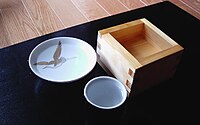
Photo from wikipedia
Isoamyl acetate is an important flavor compound in sake. However, production of isoamyl acetate by Saccharomyces cerevisiae is significantly reduced during sake brewing with rice that has a high polishing… Click to show full abstract
Isoamyl acetate is an important flavor compound in sake. However, production of isoamyl acetate by Saccharomyces cerevisiae is significantly reduced during sake brewing with rice that has a high polishing ratio, because unsaturated fatty acids derived from the outer layer of rice repress the expression of ATF1, which encodes an alcohol acetyl transferase. Yeast mutants capable of relieving this repression would allow the brewing of rice with high polishing ratios, improving the diversity of taste and flavor of sake. Atf1p is also believed to contribute to biological membrane homeostasis. We isolated four yeast mutants (hia1, hia2, hia4, and hia6) that have high isoamyl acetate productivity and are resistant to aureobasidin A, an inhibitor of sphingolipid biosynthesis. The isoamyl acetate content of sake brewed with the hia1 mutant was 2.6 times higher than that of the parental strain. ATF1 was expressed constitutively in the hia1 mutant during brewing and remained derepressed upon the addition of unsaturated fatty acids. Whole-genome sequence analysis of the hia mutants revealed a homozygous nonsense mutation (Ser706*) in MGA2 in all four mutants. Mga2p, an endoplasmic reticulum (ER) membrane protein, regulates ATF1 transcription. The expression of ATF1 was elevated in BY4743 Δmga2 cells complemented with MGA2 (Ser706*), and this was not completely inhibited by the addition of unsaturated fatty acids. These results indicate that a nonsense mutation in MGA2 induces high levels of isoamyl acetate production in S. cerevisiae. This finding has applications for brewing sake with high levels of isoamyl acetate.
Journal Title: Journal of bioscience and bioengineering
Year Published: 2017
Link to full text (if available)
Share on Social Media: Sign Up to like & get
recommendations!